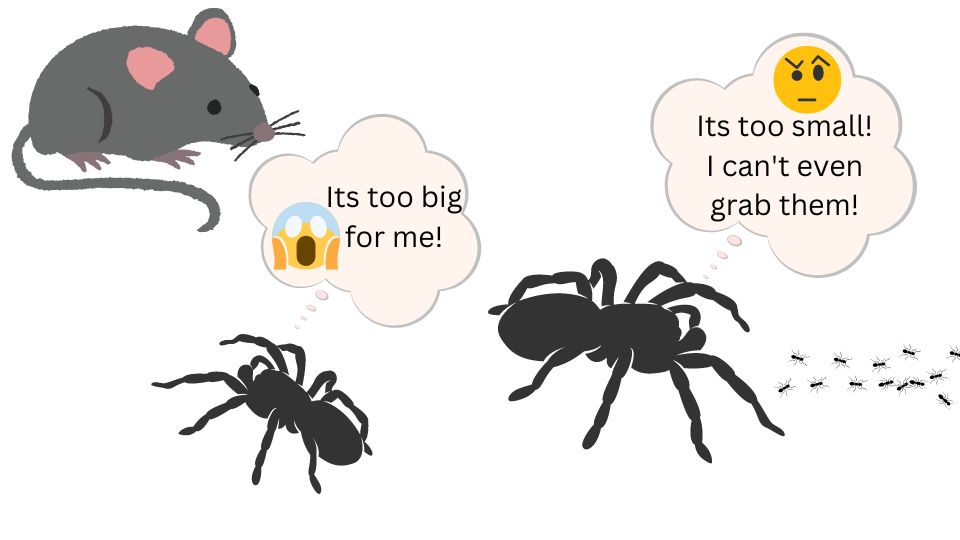Your tarantula is not eating any food that you offer, and you are worried. Here are the 9 reasons why your tarantula is not eating, and how to deal with it.
Your tarantula is molting

Tarantulas grow by molting. They stop feeding when they are about to molt (we call it premolt). Premolt can last a few days for young juveniles, and weeks for adults. In extreme cases observed in Theraphosa blondi, a premolt can last for 3 months.
During the premolt period, your tarantula becomes weaker. Don’t try to give it any prey that can harm it, and don’t leave the prey overnight in the enclosure, since you don’t know when it will molt.
If you are keeping New World tarantulas, you can identify the sign of premolt by looking at the bald patch on the opisthosoma (aka abdomen) of your tarantula. As it gets closer to molt, the color of the bald patch becomes darker.
Your tarantula is defenseless when it molts. No prey should be inside the enclosure when it is molting. The prey may disturb the molting process, and kill the tarantula. Certain prey may even attack your molting tarantulas.
After molting, it takes days or weeks for the tarantula’s new exoskeleton to harden, depending on its size. The tarantula will regain its appetite after a few days, weeks, or even months (in Theraphosa blondi for example).
Ensure your tarantula is hydrated by topping up the water dish, and it will be fine.
Learn more about caring for molting tarantula here.
Your tarantula is fasting
Tarantulas are known to fast. We don’t know what triggers fasting, nor the benefit behind it.
It is completely normal for some tarantulas to stop eating for months. There were extreme cases where Grammostola rosea was reported to fast for 1 year or more without apparent health issues.
Try offering your tarantula food every alternate week until it feeds. It is crucial to maintain consistent humidity and water supply for the tarantula. While tarantulas can fast, they can’t survive without water.
It is too cold

Generally, tarantulas are more active and have a higher metabolism when it is warmer. When it gets cold (especially in the winter), tarantulas become inactive, and may not feed. It is OK if the temperature change is seasonal. Tarantulas are known to overwinter without feeding
While heat control is generally not required for tarantulas, you can choose to give your tarantulas some extra heat in the winter to keep it active.
Put the heat mat at a corner, but not the center of the tarantula enclosure. Monitor the temperature closely, so that you don’t kill your tarantula by overheating it.
If you are providing extra heat to your tarantula, pay attention to the humidity in the enclosure. The extra heat will make the water in the substrates or water dish evaporate faster. You might need to replenish the water more frequently.
You feed it too frequently
Tarantulas don’t eat a lot. If you are offering them food more than twice a week, it’s probably too much.
As a general rule of thumb, your young juvenile tarantulas should be given food at most twice a week if you want them to grow fast. Once they molt for 2-3 times, cut down the feeding frequency to once a week.
An adult tarantula requires 1-2 crickets a week. Their metabolism has slowed down, and therefore doesn’t require much food. In contrast, younger juveniles need more food (relative to their body size) than older juveniles, as they are growing very fast.
The size of the feeder insect is not right

No matter how strong you think your tarantula is, you should never feed it with large prey. Keep the size of your feeder insect smaller than the size of your tarantula’s opisthosoma, especially if you have a juvenile tarantula.
If the prey is too big, your tarantula may choose to walk away instead of attacking it.
Some tarantulas are capable of attacking prey bigger than their size. Treat that as an exception, rather than norms. Moreover, your tarantula may be injured if the prey decides to fight back.
In case it is not obvious, tarantulas can’t hunt prey that is too small. For example, don’t expect a 4″ tarantula to hunt for a small springtail!
Your tarantula could be picky
Like humans, some tarantulas may have special food preferences.
Tarantulas can eat different prey when given a chance. But, some individuals simply don’t eat food they are not familiar with, even though the species is commonly known to feed on those foods.
For instance, some tarantulas may eat darkling beetles (the adult form of mealworms), but others (of the same species) will avoid them.
If you are giving your tarantula new food that it has not eaten before, and it ignores the food, change back to the routine food. That will solve the issue.
It has not acclimated to the new environment
If you just get your tarantula, it may not have gotten used to its new home. The tarantula becomes stressful, and it may not eat anything.
This is especially true if the tarantula has been moved from a location with a different season than yours.
You can only wait patiently. Try feeding your tarantula after a week. It should start eating by then. And if it doesn’t, wait for another week.
Make sure your tarantula housing has been set up correctly, according to the tarantula’s needs. For example, you need a vertical tank for arboreal species, and enough substrates for burrowers. Humidity and lighting requirements have to be well taken care of too. By giving your tarantula a habitat that suits its needs, you can help it to acclimate faster.
Generally, tarantulas are nocturnal. Try to feed them at night instead of during the day.
It is sick
Like humans, tarantulas can get sick. Not all tarantulas that fall ill will lose appetite, but sickness is definitely a reason why they stop eating.
Unfortunately, there is nothing that you can do for your tarantula to make it get well. It may survive and recover, or succumb to the illness and die. Just give it water, and hope it gets well and start eating.
You can help to prevent illness by giving your tarantula clean water (preferably drinking water) and feeder insects from reputable breeders. Crickets, for example, may carry ringworms that can infect the tarantulas. Using feeder insects from a reliable source can reduce the risk.
If your tarantula is not eating, and has white color masses around its mouthparts, it is infected by Tarantobelus jeffdanielsi, a species of nematode. The white masses are the nematodes themselves.
Infected tarantulas lose control of their mouthparts and hence can’t feed. They also display a weird behavior where they walk on their toe tips. At the moment, there’s no cure for this. Your tarantula will soon die from starvation.
What you can do is prevent spreading the nematodes to other healthy tarantulas, if you are keeping multiple tarantulas.
Isolate your infected tarantula in another room. Don’t share the tools that you use for healthy tarantulas (eg. tweezers). Use separate tools. Always wash and disinfect your hands and tools after caring for your ill tarantulas, so that you don’t spread the nematodes.
Avoid caring for both sick and healthy tarantulas at the same time or on the same day. Always handle the healthy tarantulas first, if you want to do it on the same day.
She is laying eggs
If your female tarantula is hiding inside her web, and doesn’t come out for food, don’t worry. She is probably laying eggs.
Don’t attempt to disturb the tarantula. She will emerge from the webs once she is done, and you can resume the feeding regime.


